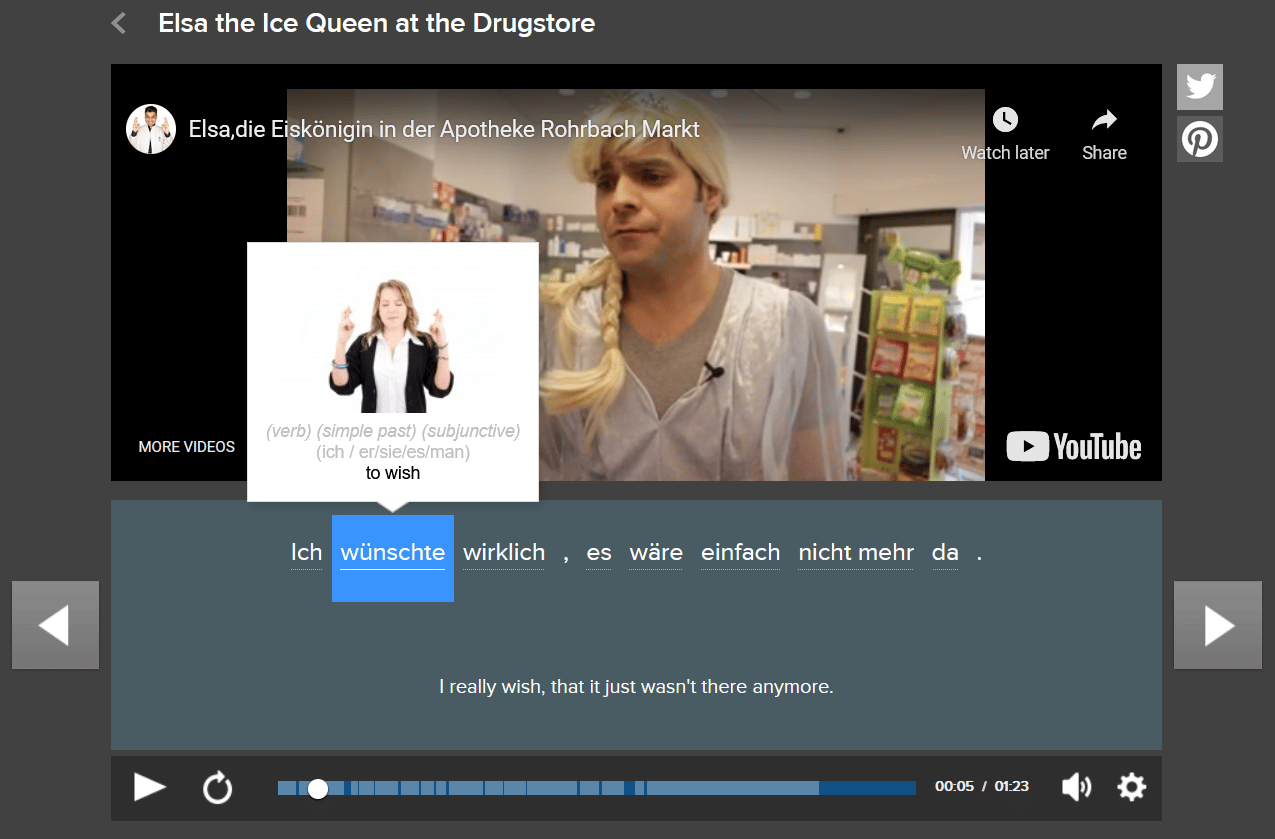
8 Ways to Get Unstuck from a Language Learning Plateau
Have you ever found yourself on the dreaded language learning plateau?
Yep, your language education was moving along smoothly, and then it suddenly seemed to halt or slow down drastically, right?
“Moving Beyond the Intermediate EFL Learning Plateau” by Qing Xu points out that this plateau is unavoidable but can be overcome.
So, let’s look at eight ways to get past what’s keeping you from fluency.
Contents
- Best Ways to Get Out from Language Learning Plateau
- 1. Set clear and realistic goals based on your current language level
- 2. Use real-world materials to make your studies engaging and dynamic
- 3. Change things up and try new learning methods
- 4. Take a proficiency test and focus on your problem areas
- 5. Learn more new vocabulary
- 6. Try to speak your target language with native speakers
- 7. Build your confidence and share your experience with other learners
- 8. Don’t let discouragement slow down your progress
- What’s a Language Learning Plateau?
- Why Do Language Learning Plateaus Occur?
Download: This blog post is available as a convenient and portable PDF that you can take anywhere. Click here to get a copy. (Download)
Best Ways to Get Out from Language Learning Plateau
1. Set clear and realistic goals based on your current language level
Once you’ve plateaued, not knowing what to do next can make your studying less focused, so your learning will slow down even more.
Setting clear goals gives you the focus you need to surge ahead. It’s important to base these goals on your current language level and make them realistic. Setting a specific timeline for your goal is also a good way to keep yourself on the right track.
Overly ambitious goals, like becoming fluent in a week, can demotivate you by setting you up for failure. Set realistic goals that are somewhat challenging but that you know you can achieve.
For instance, you might resolve to learn a new set of vocabulary words or memorize irregular verb conjugations in the next week.
Regardless of what your goals are, having these clear benchmarks will help keep you moving in the right direction.
2. Use real-world materials to make your studies engaging and dynamic
Most students will have focused on resources for learners up until they plateau. While this is a helpful way to understand the underlying structure and rules of a language, you’ll need to start consuming more authentic material to make your push towards fluency.
This can include real stories in your target language, news articles and even movies and TV shows.
There are many language learning programs that harness the power of real-world language usage but help learners manage the overwhelming feelings of “in the wild” language usage.
For example, FluentU uses bite-sized authentic videos featuring native speakers to help you learn a language in context. Video types include movie trailers, series clips, news segments, vlogs and many more native bits of media.
Each clip’s interactive subtitles comprehensively explain the vocabulary used, and you can review words with multimedia flashcards and personalized quizzes. You can filter videos by topic and format to discover content you’ll find engaging, and by difficulty level for videos that are at just the right skill level for you.
The program even lets you practice your pronunciation with “speaking questions” for a well-rounded learning routine.
FluentU is currently available for 10 languages, all of which can be accessed under one subscription: English, Spanish, French, German, Italian, Portuguese, Chinese, Korean, Japanese and Russian. The program can be used in a browser or you can install it on your iOS or Android device—don’t worry, it tracks your progress across all devices so you can pick right up from where you left off in any language.
Authentic content can make your language studies more engaging and dynamic, providing fantastic learning and review opportunities that can propel you out of your plateau.
3. Change things up and try new learning methods
Since your language learning has slowed down, now is the perfect opportunity to change up whatever you’ve been doing. It’s possible that you’re just stuck in a rut with that method. Trying something new could reinvigorate your language education.
For example, you can try double translation. It’s when you translate a text from one language to another and then back again. This is a helpful way to build vocabulary and practice your reading and writing skills.
Moreover, if you’ve been taking a class or studying a textbook, you might try immersion, language learning software or language learning apps.
Or, you could even take a course in your target language. Here are some platforms that can help you with that:
- Coursera offers courses on a variety of subjects, and in addition to courses taught in English, you can find some taught in French, Spanish, Mandarin Chinese and other languages.
- Udemy offers self-paced courses accessible on any device that cover many topics.
- If you want to try the challenge of taking a real university-level course in your target language, edX has courses from schools like Harvard and MIT.
If you’ve relied on immersion, on the other hand, now would be a good time to crack a textbook to get a more thorough understanding of underlying grammar rules.
Regardless of what you’ve been doing, changing things up is an easy way to get out of your rut and see the language from a new angle.
4. Take a proficiency test and focus on your problem areas
Taking proficiency tests and assessing your own skills will help you determine what areas you need to work on. Dialang is a particularly useful free online proficiency test because you can test multiple skills individually to see what skills are your weakest.
Another way to assess your own skill without a proficiency test is to think through what you’re most comfortable with. If you had to communicate with a native speaker, would you feel more comfortable doing it through speaking or writing? Would you feel more comfortable hearing or reading a native speaker’s response? Chances are that the skill you prefer is your stronger skill, so focus on the skill you didn’t choose.
While you may be at an intermediate level overall, chances are that you have some areas that are stronger and some areas that are weaker. Once you find these areas, all you have left to do is work on improving your weak points!
For example, if you struggle with listening, do more listening exercises. Similarly, if you struggle with speaking, find opportunities to speak. You might even start a public speaking club in your target language!
Additionally, if you struggle with a particular grammar rule, you can dedicate more time and effort to finally nailing it down.
Not only will putting time and effort into improving your problem areas improve your language skills, it will also make your confidence skyrocket.
5. Learn more new vocabulary
Limited vocabulary is one of the main hurdles that keeps intermediate learners stuck in the plateau phase.
Learning vocabulary is essential to get to fluency. You can choose vocabulary sets by considering what words your vocabulary lacks. For instance, many intermediate learners don’t have as many verbs as would be desirable, so this is a good place to start. You might also be lacking more academic language, so words related to your academic interests could also be beneficial.
Quizlet is a helpful place to find and study thematic vocabulary sets. All you have to do is type in keywords and you’ll find plenty of user-created lists. You can print off the lists to study, you can play games on the site or you can use flashcards on the site.
VTrain.net is a free software you can use to create and review your own flashcards, allowing you to choose the vocabulary that you find most important. Flashcard apps like Cram (available for iOS and Android) are also useful learning tools that allow you to build your vocabulary in whatever minutes you have to spare.
Building your vocabulary won’t only help you keep your learning on track, it will also help you communicate more clearly and concisely.
6. Try to speak your target language with native speakers
Most language students focus on a generic form of their target language early in their education. Once you’ve plateaued, the next logical step is to learn to speak more like a native. Interacting with native speakers is terrific for speaking practice, listening practice, vocabulary building and pronunciation improvement.
Conversation exchange is an awesome tool for this. Conversation exchange is when you partner with a speaker of your target language. You get practice in your target language, and you give your partner practice in your native language. If you can’t find a native speaker near you, there are plenty of online solutions.
For instance, Conversation Exchange can help you find a native speaker near you or arrange a penpal correspondence. TalkAbroad can also help you schedule online video conversations with a native speaker. Skype language exchange is a popular way to connect with native speakers all over the world.
Many conversation exchange sites even offer estimated skill levels for participants. If you find someone at an intermediate skill level in your native language, they, too, are probably around the language learning plateau stage.
Once you start speaking your target language with native speakers, your skill and confidence will propel you past the plateau.
7. Build your confidence and share your experience with other learners
Working on your skills in general will help improve your confidence, but the best way to improve your confidence is to use your target language and use it often.
If you don’t speak, listen to, read and write in your target language often, you won’t have the time to build the confidence you need to continue forward towards fluency. When you’re learning, native-level skills seem impossible. This is why it’s important to use your skills in a supportive context. Get together with or make friends who are at a similar stage in their learning progress. If you’re not sure how to do this, check out some language learning communities.
Together, you can commiserate about the difficulties you’re facing and get some valuable practice in. Even if you make friends with someone learning a different language, there’s nothing to stop you from speaking to them in your target language (and it might even be less daunting this way)! Similarly, if you’re reading or writing alongside a friend, there’s someone there to push you forward if you ever feel like quitting.
As long as you use the language more often, your confidence will grow until full fluency is within reach.
8. Don’t let discouragement slow down your progress
Once your learning slows down, it can be easy to become discouraged. You may even stop trying to improve your language skills. But don’t let discouragement weigh you down! Learning a language is like a marathon. When you start, it’s easy to move quickly. However, the farther you go, the more your pace is likely to slow. When things seem impossible, it’s important to remember that you’ve come a long way.
Sure, it was more fun to move faster, but quitting now that the finish line of fluency is in sight is a mistake you may regret. You’ve already put this much work in. Don’t let discouragement stop you from finishing the race!
What’s a Language Learning Plateau?
A language learning plateau occurs when you stop learning as much as quickly. It’s easy to make quick progress early on, but as you learn more, you naturally slow down. Because of this, a language learning plateau frequently occurs when learners reach an intermediate level of language proficiency.
Why Do Language Learning Plateaus Occur?
There are a few reasons why you may be experiencing a language learning plateau.
- You’ve met your goals. A lot of learners set goals that are reached by the time they reach an intermediate level. For instance, you might want to be able to hold a basic conversation or be able to read a newspaper or book in your target language. If you’ve met all your learning goals, your learning will naturally pause.
- You don’t have goals. Whether you never had any goals to begin with or you just haven’t set new ones since you achieved your previous objectives, not having goals can halt language learning progress. Without a clear idea of what you hope to achieve, you don’t have a clear direction for focused study.
- You’re stuck on a loop, doing the same thing all the time. If you keep doing the same thing, you’re likely to keep getting the same results. However, once you’ve milked one particular method for all it’s worth, you’ll see your learning plateau.
- You lack confidence. As an intermediate learner, you’ve come a long way, but you also know enough to realize there’s a lot you don’t know. This can diminish confidence and make you feel like you can’t possibly become fluent or communicate as clearly as you’d like.
- There’s a natural slowdown. Even if you do everything right, language learning plateaus can naturally occur. It’s not a fun truth, but at the same time, at least you aren’t solely responsible for your current rut!
The road to language fluency may not be a continual rise.
There will definitely be some flat ground along the way.
But if you follow these tips, you can overcome your language learning plateau and continue along your way to fluency with confidence!
Download: This blog post is available as a convenient and portable PDF that you can take anywhere. Click here to get a copy. (Download)












